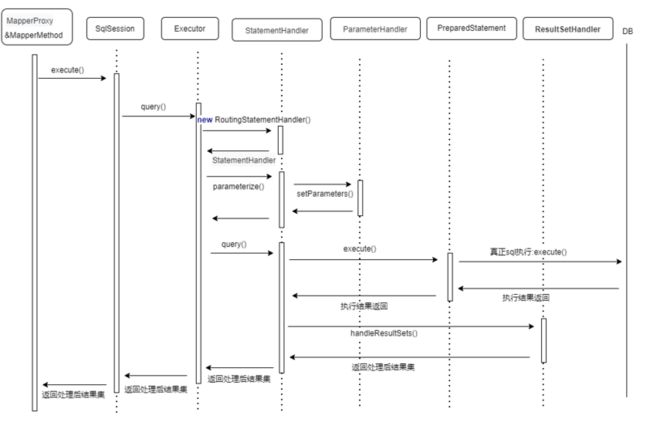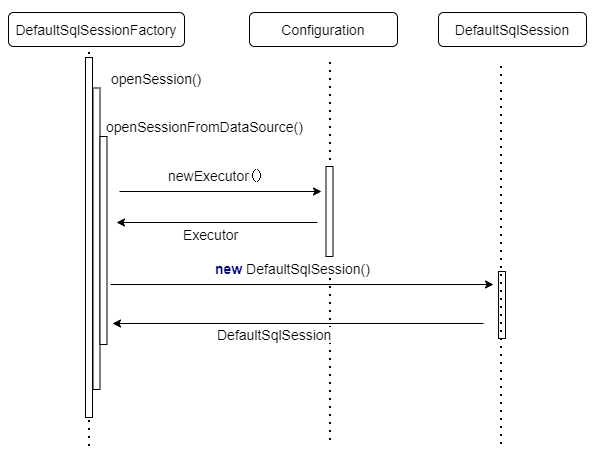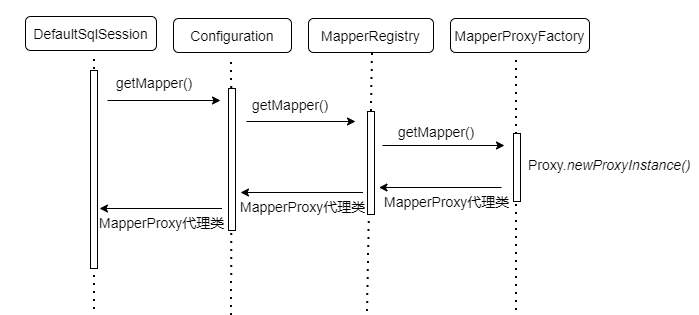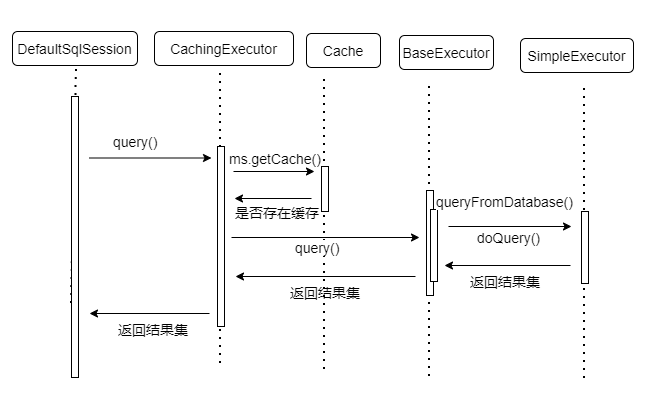前言
在了解了MyBatis初始化加载过程后,我们也应该研究看看SQL执行过程是怎样执行?这样我们对于Mybatis的整个执行流程都熟悉了,在开发遇到问题也可以很快定位到问题。
更重要的,在面试中遇到面试官咨询Mybatis的知识点的时候,可以很顺畅的把这一套流程讲出来,面试官也会觉得你已掌握Mybatis知识点了,可能就不问了。赶紧瞄瞄
简介SQL执行过程
经过MyBatis初始化加载Sql执行过程所需的信息后,我们就可以通过 SqlSessionFactory 对象得到 SqlSession ,然后执行 SQL 语句了,接下来看看Sql执行具体过程,SQL大致执行流程图如下所示:
接下来我们来看看每个执行链路中的具体执行过程,
SqlSession
SqlSession 是 MyBatis 暴露给外部使用的统一接口层,通过 SqlSessionFactory 创建,且其是包含和数据库打交道所有操作接口。
下面通过时序图描述 SqlSession 对象的创建流程:
在生成SqlSession的同时,基于executorType初始化好Executor 实现类。
public Executor newExecutor(Transaction transaction, ExecutorType executorType) {
executorType = executorType == null ? defaultExecutorType : executorType;
executorType = executorType == null ? ExecutorType.SIMPLE : executorType;
Executor executor;
if (ExecutorType.BATCH == executorType) {
executor = new BatchExecutor(this, transaction);
} else if (ExecutorType.REUSE == executorType) {
executor = new ReuseExecutor(this, transaction);
} else {
executor = new SimpleExecutor(this, transaction);
}
if (cacheEnabled) {
executor = new CachingExecutor(executor);
}
executor = (Executor) interceptorChain.pluginAll(executor);
return executor;
}最顶层的SqlSession接口已生成,那我们可以来看看sql的执行过程下一步是怎样的呢?怎样使用代理类MapperProxy。
MapperProxy
MapperProxy 是 Mapper接口与SQL 语句映射的关键,通过 MapperProxy 可以让对应的 SQL 语句跟接口进行绑定的,具体流程如下:
MapperProxy代理类生成流程MapperProxy代理类执行操作
MapperProxy代理类生成流程
其中,MapperRegistry 是 Configuration 的一个属性,在解析配置时候会在MapperRegistry 中缓存了 MapperProxyFactory 的 knownMappers 变量Map 集合。
`MapperRegistry 会根据mapper接口类型获取已缓存的MapperProxyFactory,MapperProxyFactory会基于SqlSession来生成MapperProxy代理对象,
public T getMapper(Class type, SqlSession sqlSession) {
MapperProxyFactory mapperProxyFactory = (MapperProxyFactory)this.knownMappers.get(type);
if (mapperProxyFactory == null) {
throw new BindingException("Type " + type + " is not known to the MapperRegistry.");
} else {
try {
return mapperProxyFactory.newInstance(sqlSession);
} catch (Exception var5) {
throw new BindingException("Error getting mapper instance. Cause: " + var5, var5);
}
}
} 当调用SqlSession接口时,MapperProxy怎么是实现的呢?MyBatis 的 Mapper接口 是通过动态代理实现的,调用 Mapper 接口的任何方法都会执行 MapperProxy::invoke() 方法,
public Object invoke(Object proxy, Method method, Object[] args) throws Throwable {
try {
//Object类型执行
if (Object.class.equals(method.getDeclaringClass())) {
return method.invoke(this, args);
}
//接口默认方法执行
if (method.isDefault()) {
if (privateLookupInMethod == null) {
return this.invokeDefaultMethodJava8(proxy, method, args);
}
return this.invokeDefaultMethodJava9(proxy, method, args);
}
} catch (Throwable var5) {
throw ExceptionUtil.unwrapThrowable(var5);
}
MapperMethod mapperMethod = this.cachedMapperMethod(method);
return mapperMethod.execute(this.sqlSession, args);
}但最终会调用到mapperMethod::execute() 方法执行,主要是判断是 INSERT、UPDATE、DELETE 、SELECT 语句去操作,其中如果是查询的话,还会判断返回值的类型。
public Object execute(SqlSession sqlSession, Object[] args) {
Object result;
Object param;
switch(this.command.getType()) {
case INSERT:
param = this.method.convertArgsToSqlCommandParam(args);
result = this.rowCountResult(sqlSession.insert(this.command.getName(), param));
break;
case UPDATE:
param = this.method.convertArgsToSqlCommandParam(args);
result = this.rowCountResult(sqlSession.update(this.command.getName(), param));
break;
case DELETE:
param = this.method.convertArgsToSqlCommandParam(args);
result = this.rowCountResult(sqlSession.delete(this.command.getName(), param));
break;
case SELECT:
if (this.method.returnsVoid() && this.method.hasResultHandler()) {
this.executeWithResultHandler(sqlSession, args);
result = null;
} else if (this.method.returnsMany()) {
result = this.executeForMany(sqlSession, args);
} else if (this.method.returnsMap()) {
result = this.executeForMap(sqlSession, args);
} else if (this.method.returnsCursor()) {
result = this.executeForCursor(sqlSession, args);
} else {
param = this.method.convertArgsToSqlCommandParam(args);
result = sqlSession.selectOne(this.command.getName(), param);
if (this.method.returnsOptional() && (result == null || !this.method.getReturnType().equals(result.getClass()))) {
result = Optional.ofNullable(result);
}
}
break;
case FLUSH:
result = sqlSession.flushStatements();
break;
default:
throw new BindingException("Unknown execution method for: " + this.command.getName());
}
if (result == null && this.method.getReturnType().isPrimitive() && !this.method.returnsVoid()) {
throw new BindingException("Mapper method '" + this.command.getName() + " attempted to return null from a method with a primitive return type (" + this.method.getReturnType() + ").");
} else {
return result;
}
}
通过以上的分析,总结出
Mapper接口实际对象为代理对象MapperProxy;MapperProxy继承InvocationHandler,实现invoke方法;MapperProxyFactory::newInstance()方法,基于 JDK 动态代理的方式创建了一个MapperProxy的代理类;- 最终会调用到
mapperMethod::execute()方法执行,完成操作。 - 而且更重要一点是,
MyBatis使用的动态代理和普遍动态代理有点区别,没有实现类,只有接口,MyBatis 动态代理类图结构如下所示:
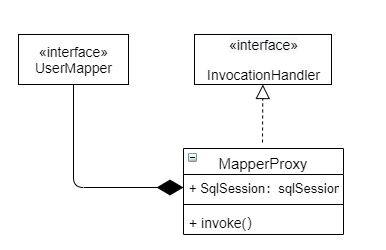
已以SELECT 为例, 调用会SqlSession ::selectOne() 方法。继续往下执行,会执行 Executor::query() 方法。
public List selectList(String statement, Object parameter, RowBounds rowBounds) {
List var5;
try {
MappedStatement ms = this.configuration.getMappedStatement(statement);
var5 = this.executor.query(ms, this.wrapCollection(parameter), rowBounds, Executor.NO_RESULT_HANDLER);
} catch (Exception var9) {
throw ExceptionFactory.wrapException("Error querying database. Cause: " + var9, var9);
} finally {
ErrorContext.instance().reset();
}
return var5;
} 执行到Executor类,那么我们来看看其究竟有什么?
Executor
Executor对象为SQL 的执行引擎,负责增删改查的具体操作,顶层接口SqlSession中都会有一个 Executor 对象,可以理解为 JDBC 中 Statement 的封装版。
Executor 是最顶层的是执行器,它有两个实现类,分别是BaseExecutor和 CachingExecutor
BaseExecutor是一个抽象类,实现了大部分Executor接口定义的功能,降低了接口实现的难度。BaseExecutor基于适配器设计模式之接口适配会有三个子类,分别是SimpleExecutor、ReuseExecutor和BatchExecutor。SimpleExecutor: 是 MyBatis 中默认简单执行器,每执行一次update或select,就开启一个Statement对象,用完立刻关闭Statement对象ReuseExecutor: 可重用执行器, 执行update或select,以sql作为key查找Statement对象,存在就使用,不存在就创建,用完后,不关闭Statement对象,而是放置于Map内,供下一次使用。简言之,就是重复使用Statement对象BatchExecutor: 批处理执行器,用于执行update(没有select,JDBC批处理不支持select将多个 SQL 一次性输出到数据库,
CachingExecutor: 缓存执行器,为Executor对象增加了二级缓存的相关功:先从缓存中查询结果,如果存在就返回之前的结果;如果不存在,再委托给Executor delegate去数据库中取,delegate可以是上面任何一个执行器。
在Mybatis配置文件中,可以指定默认的ExecutorType执行器类型,也可以手动给DefaultSqlSessionFactory的创建SqlSession的方法传递ExecutorType类型参数。
看完Exector简介之后,继续跟踪执行流程链路分析,SqlSession 中的 JDBC 操作部分最终都会委派给 Exector 实现,Executor::query()方法,看看在Exector的执行是怎样的?
每次查询都会先经过CachingExecutor缓存执行器, 会先判断二级缓存中是否存在查询 SQL ,如果存在直接从二级缓存中获取,不存在即为第一次执行,会直接执行SQL 语句,并创建缓存,都是由CachingExecutor::query()操作完成的。
public List query(MappedStatement ms, Object parameterObject, RowBounds rowBounds, ResultHandler resultHandler) throws SQLException {
BoundSql boundSql = ms.getBoundSql(parameterObject);
CacheKey key = this.createCacheKey(ms, parameterObject, rowBounds, boundSql);
return this.query(ms, parameterObject, rowBounds, resultHandler, key, boundSql);
}
public List query(MappedStatement ms, Object parameterObject, RowBounds rowBounds, ResultHandler resultHandler, CacheKey key, BoundSql boundSql) throws SQLException {
//获取查询语句对应的二级缓存
Cache cache = ms.getCache();
//sql查询是否存在在二级缓存中
if (cache != null) {
//根据 如果在经过CachingExecutor缓存执行器(二级缓存)没有返回值的话,就会执行BaseExecutor 以及其的实现类,默认为SimpleExecutor ,首先会在一级缓存中获取查询结果,获得不到,最终会通过SimpleExecutor:: ()去数据库中查询。
public List query(MappedStatement ms, Object parameter, RowBounds rowBounds, ResultHandler resultHandler, CacheKey key, BoundSql boundSql) throws SQLException {
ErrorContext.instance().resource(ms.getResource()).activity("executing a query").object(ms.getId());
if (this.closed) {
throw new ExecutorException("Executor was closed.");
} else {
//是否清除本地缓存
if (this.queryStack == 0 && ms.isFlushCacheRequired()) {
this.clearLocalCache();
}
List list;
try {
++this.queryStack;
//从一级缓存中,获取查询结果
list = resultHandler == null ? (List)this.localCache.getObject(key) : null;
//获取到结果,则进行处理
if (list != null) {
this.handleLocallyCachedOutputParameters(ms, key, parameter, boundSql);
} else {
//获得不到,则从数据库中查询
list = this.queryFromDatabase(ms, parameter, rowBounds, resultHandler, key, boundSql);
}
} finally {
--this.queryStack;
}
if (this.queryStack == 0) {
//执行延迟加载
Iterator var8 = this.deferredLoads.iterator();
while(var8.hasNext()) {
BaseExecutor.DeferredLoad deferredLoad = (BaseExecutor.DeferredLoad)var8.next();
deferredLoad.load();
}
this.deferredLoads.clear();
if (this.configuration.getLocalCacheScope() == LocalCacheScope.STATEMENT) {
this.clearLocalCache();
}
}
return list;
}
} 那么SimpleExecutor::doQuery()如何去数据库中查询获取到结果呢?其实执行到这边mybatis的执行过程就从 Executor转交给 StatementHandler处理,
public List doQuery(MappedStatement ms, Object parameter, RowBounds rowBounds, ResultHandler resultHandler, BoundSql boundSql) throws SQLException {
Statement stmt = null;
List var9;
try {
Configuration configuration = ms.getConfiguration();
StatementHandler handler = configuration.newStatementHandler(this.wrapper, ms, parameter, rowBounds, resultHandler, boundSql);
stmt = this.prepareStatement(handler, ms.getStatementLog());
var9 = handler.query(stmt, resultHandler);
} finally {
this.closeStatement(stmt);
}
return var9;
} 这样我们的执行链路分析已到StatementHandler了,现在让我们去一探究竟其原理
StatementHandler
StatementHandler负责处理Mybatis与JDBC之间Statement的交互,即Statement 对象与数据库进行交互,其为顶级接口,有4个实现类,其中三个是Statement 对象与数据库进行交互类, 另外一个是路由功能的,
RoutingStatementHandler: 对Statement对象没有实际操作,主要负责另外三个StatementHandler的创建及调用, 而且在MyBatis执行时,使用的StatementHandler接口对象实际上就是RoutingStatementHandler对象。SimpleStatementHandler: 管理 Statement 对象, 用于简单SQL的处理 。PreparedStatementHandler: 管理 Statement 对象,预处理SQL的接口 。CallableStatementHandler:管理 Statement 对象,用于执行存储过程相关的接口 。
在经历过Executor后,基于初始化加载到MapperState中的StatementType的类型通过Configuration.newStatementHandler()方法中的RoutingStatementHandler 生成StatementHandler实际处理类。
public RoutingStatementHandler(Executor executor, MappedStatement ms, Object parameter, RowBounds rowBounds, ResultHandler resultHandler, BoundSql boundSql) {
switch(ms.getStatementType()) {
case STATEMENT:
this.delegate = new SimpleStatementHandler(executor, ms, parameter, rowBounds, resultHandler, boundSql);
break;
case PREPARED:
this.delegate = new PreparedStatementHandler(executor, ms, parameter, rowBounds, resultHandler, boundSql);
break;
case CALLABLE:
this.delegate = new CallableStatementHandler(executor, ms, parameter, rowBounds, resultHandler, boundSql);
break;
default:
throw new ExecutorException("Unknown statement type: " + ms.getStatementType());
}
}现在先以PreparedStatementHandler预处理为例,接着Sql的执行链路来分析,StatementHandler::query()到StatementHandler::execute()真正执行Sql查询操作。
public List query(Statement statement, ResultHandler resultHandler) throws SQLException {
String sql = boundSql.getSql();
statement.execute(sql);
return resultSetHandler.handleResultSets(statement);
} 但执行真正查询操作之前,还进行哪些处理呢?还会进行ParameterHandler对 SQL 参数的预处理:对参数进行动态Sql映射,那么ParameterHandler又如何实现对参数进行动态映射的呢?
ParameterHandler
ParameterHandler 参数处理器, 用来设置参数规则的,负责为sql 语句参数动态赋值,其有两个接口
- getParameterObject: 用于读取参数
- setParameters: 用于对 PreparedStatement 的参数赋值
当SimpleExecutor执行构造PreparedStatementHandler完,会调用parameterize()方法将PreparedStatement对象里SQL转交ParameterHandler实现类 DefaultParameterHandler::setParameters()方法 设置 PreparedStatement 的占位符参数 。
private Statement prepareStatement(StatementHandler handler, Log statementLog) throws SQLException {
Statement stmt;
Connection connection = getConnection(statementLog);
stmt = handler.prepare(connection, transaction.getTimeout());
//参数动态赋值
handler.parameterize(stmt);
return stmt;
}DefaultParameterHandler::setParameters()如何对SQL进行动态赋值呢?在执行前将已装载好的BoundSql对象信息进行使用
public void setParameters(PreparedStatement ps) {
ErrorContext.instance().activity("setting parameters").object(mappedStatement.getParameterMap().getId());
//获取待动态赋值参数列表的封装parameterMappings
List parameterMappings = boundSql.getParameterMappings();
if (parameterMappings != null) {
for (int i = 0; i < parameterMappings.size(); i++) {
ParameterMapping parameterMapping = parameterMappings.get(i);
//是否为输入参数
if (parameterMapping.getMode() != ParameterMode.OUT) {
Object value;
//获取待动态参数属性名
String propertyName = parameterMapping.getProperty();
if (boundSql.hasAdditionalParameter(propertyName)) { // issue #448 ask first for additional params
value = boundSql.getAdditionalParameter(propertyName);
} else if (parameterObject == null) {
value = null;
} else if (typeHandlerRegistry.hasTypeHandler(parameterObject.getClass())) {
value = parameterObject;
} else {
MetaObject metaObject = configuration.newMetaObject(parameterObject);
value = metaObject.getValue(propertyName);
}
//// 在通过 SqlSource 的parse 方法得到parameterMappings 的具体实现中,我们会得到parameterMappings 的 typeHandler
TypeHandler typeHandler = parameterMapping.getTypeHandler();
//获取jdbc数据类型
JdbcType jdbcType = parameterMapping.getJdbcType();
if (value == null && jdbcType == null) {
jdbcType = configuration.getJdbcTypeForNull();
}
try {
//
typeHandler.setParameter(ps, i + 1, value, jdbcType);
} catch (TypeException | SQLException e) {
throw new TypeException("Could not set parameters for mapping: " + parameterMapping + ". Cause: " + e, e);
}
}
}
}
} 执行完SQL 参数的预处理,当StatementHandler::execute()真正执行查询操作执行完后,有返回结果,需要对返回结果进行ResultSetHandler处理,现在看看最后的结果的处理流程。
ResultSetHandler
ResultSetHandler 结果解析器,将查询结果的ResultSet 转换成映射的对应结果(java DTO等),其有三接口
handleResultSets():处理结果集handleCursorResultSets():批量处理结果集handleOutputParameters():处理存储过程返回的结果集
其默认的实现为DefaultResultSetHandler,主要功能为:
- 处理
Statement执行后产生的结果集生成相对的输出结果、 - 处理存储过程执行后的输出参数
那看看DefaultResultSetHandler::handleResultSets()如何处理?
- 当有多个
ResultSet的结果集合,每个ResultSet对应一个Object 对象,如果不考虑存储过程,普通的查询只有一个ResultSet ResultSetWrapper封装了ResultSet结果集,其属性包含ResultSet,ResultMap等
@Override
public List其实在ResultSetHandler结果集处理是比较复杂的,这里只是简单的介绍一下,有兴趣的可以再深入研究一下,后期有空也会写。
执行到这边,Mybatis SQL执行基本完了,会把转换后的结果集返回到操作者。
结论
在SQL执行过程主要涉及了SqlSession,MapperProxy,Executor,StatementHandler,ParameterHandler以及ResultSetHandler,包括参数动态绑定,Sql执行查询数据库数据,结果返回集映射等,而且每个环节涉及的内容都很多,每个接口都可以抽出单独分析,后续有时间再一一详细的看看。后面还是再分析一下插件的应用。
各位看官还可以吗?喜欢的话,动动手指点个赞呗!!谢谢支持!
欢迎扫码关注,原创技术文章第一时间推出

